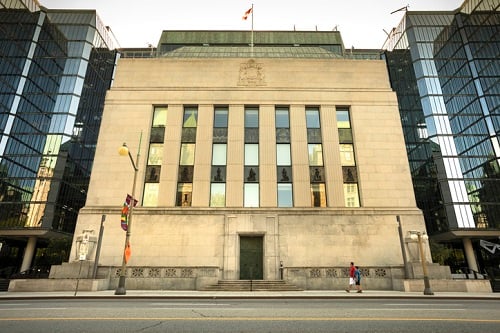Bank of Canada governor and deputy governor discuss the latest monetary policy report and the decision to hold interest rate steady for another couple of months at least

In its first announcements of the new decade, the Bank of Canada (BoC) has revealed that the overnight rate would remain at 1.75 percent and released its quarterly monetary policy report.
A lot has happened over the three months since the release of Bank’s last policy report, said BoC Governor Stephen S. Poloz. Canada’s economy keeps chugging along, and Poloz said the economy last year was stronger than previously believed. The monetary policy report indicates that even though Canada’s economic activity has slowed since last quarter of 2019, it is expected to rise again through the first half of 2020 and remain “just above the rate of potential thereafter.” Canadian growth is expected to be 1.6 percent throughout 2020, and the pace of activity is expected to increase to 2.0 percent in 2021, due to improved business investments and exports, and strengthened household spending due to population growth and the growth of disposable incomes.
“All things considered, it was governing council’s view that the balance of risk does not warrant lower interest rates at this time,” Poloz said, adding that they weighed the risk that inflation could fall short of target against the risk that a lower interest rate path would lead to higher both financial vulnerabilities, which could make it “even more difficult to attain the inflation target further down the road.”
Overall, the Bank’s analysis found that excess capacity in the Canadian economy has increased, which will bring downward pressure on inflation. This excess capacity, however, is not uniformly distributed but concentrated in the Prairies and Newfoundland and Labrador. At the same time, Poloz continued, “household financial vulnerabilities remain elevated, although we will be analysing the positive implications of a higher household savings rate for those vulnerabilities.”
Canadian consumers may have turned more cautious, Poloz said. This interpretation was reinforced by negative consumer confidence in the fourth quarter and higher savings rates. But, he adds, the forecast does not include a prolonged consumer spending slowdown; in fact, consumer confidence may have bottomed in December 2019. In addition, Poloz said, “housing remains solid in most regions of the country, even if it is growing less quickly than it did earlier in 2019.”
Although the rate hold was expected, nearly a third of economists suggested that the Bank should cut rates in a poll leading up to the announcement. Non-economists were wondering the same thing, particularly commenting about the relationship between the overnight right and the health of the housing market. Senior Deputy Governor Carolyn A. Wilkins stressed that inflation was at or near target, and they didn’t believe current situation required any change.
“If we contribute to household vulnerabilities increasing to more than where they are today, that could mean further down the road, if we have a negative shock [and] something makes growth slow, we could be in a tougher position achieving our target and it could go much further away from two percent,” Wilkins said. “The housing market is starting to stabilize in different places, we don’t see the froth, and we see more savings than we thought we had.”
Getting deeper into household vulnerabilities and government reconsideration of the stress test, Wilkins commented that the measure was first implemented at a time when interest rates were very low, and like any other policy measure, desirable tweaks have become clear after having seen it in play for a period of time. If and when changes do take place, Wilkins continued, the Bank will take a look at how it might change the accessibility of mortgage and what that might mean for the housing market.
“We’ve been very clear that we think the stress test has done a very good job of safeguarding the system and actually safeguarding individuals who are taking on mortgages so that they can be more confident that they’ll be able to handle the mortgage over the lifetime of the mortgage,” Wilkins said. “The mandate here isn’t necessarily to loosen it; it’s just to make it more dynamic with respect to how interest rates or mortgage rates actually change.”
Rather than slowing to a standstill, the global economy is showing signs of stabilizing and gradually strengthening. Manufacturing activity is beginning to pick up in many regions, service sectors remain healthy, and unemployment rates continue to remain near historic lows in many advanced economies. Global trade developments have also been positive, although ongoing geopolitical conflicts “continue to weigh on global economic activity.” Where tensions between China and the U.S. have eased, for example, they have heightened in the Middle East, adding uncertainty into financial markets.
The Bank projects that global growth will increase modestly to around 3.25 percent by 2021, having slowed somewhat in Canada and the U.S., but picking in emerging-market economies.
Poloz and Wilkins stressed that the decisions and conditions surrounding rate decisions and monetary policies are dynamic and can change over time. If rates were to be cut, Poloz said, it would no longer be an “insurance” cut against a downside risk as they were considering in October, but it would mean that the forecast was showing a “meaningful” shortfall o their inflation target, and they felt compelled to act on it.
Right now, however, things keep chugging along.
“The interest rate we have today remains appropriate for the conditions that we see,” Poloz said.



